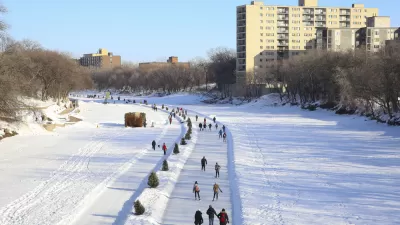Broadening our definition of parks to recognize their role in preventative health care and promotion will only expand our awareness on how important they are to good neighbourhood design.
How far of a walk is a park from you, from your home, work or school? Are there any significant obstacles in the way such as large parking lots or major intersections?
The standard in the literature suggests that a distance of 400m or a 5-minute walk to a park is ideal, which generally contributes to good neighbourhood design. In this are two qualities regarding our wellbeing: one, the ability to conveniently walk to a park and two, being in a park itself.
A park is often defined as a specific type of vegetated open space providing opportunities for organized and informal recreation from soccer to bird watching, along with having cultural and aesthetic value. The research is quite clear in indicating the correlation between recreation and physical health along with the social benefits of strengthening community bonds, environmental stewardship and youth development (see “The Health and Social Benefits of Recreation” [PDF], for further discussion).
The positive benefits of simply being in a park, or being able to see one from your window and our health, however, has tended to be anecdotal. More recently however there is growing empirical evidence recognizing this component of high quality parks.
Here are a few examples (see “Synopsis of 2010 Research Papers” [PDF], for details):
- Hospitals that provide visual access to nature see patient recovery time shortened, as well as lessening the amount of prescribed pain medications and fewer post-op complications.
- People that regularly observe well-vegetated areas have been shown to have improved cognitive function and concentration, along with better at impulse control. This tends to encompass an overall resilience to stressful life events.
- To counter the positive benefits, there is a correlation between low access to green areas and increases in ADHD, clinical depression, stress and anxiety.
- Neighbourhoods that have areas rich in vegetation have lower reported anxiety disorders among citizens. These settings also help induce a greater sense of reliance on community members thus decreasing loneliness and crime.
In this light, we can look at broadening the role or providing a more holistic definition of a park. Simply, as a component of our city fabric, they have a role in preventative health care and promotion.
Having access to and spending time in beautiful, healthy parks correlates with our overall wellbeing. They give us a sense of place, of meaning, imprint on our collective memory and are a fundamental structure in creating connections in both ourselves and our greater community. Broadening our definition of parks will only expand our awareness on how important they are to good neighbourhood design.
Steven Snell is a parks policy planner for the City of Calgary. You can contact him on Twitter: @stevenpsnell

Alabama: Trump Terminates Settlements for Black Communities Harmed By Raw Sewage
Trump deemed the landmark civil rights agreement “illegal DEI and environmental justice policy.”

Planetizen Federal Action Tracker
A weekly monitor of how Trump’s orders and actions are impacting planners and planning in America.

Why Should We Subsidize Public Transportation?
Many public transit agencies face financial stress due to rising costs, declining fare revenue, and declining subsidies. Transit advocates must provide a strong business case for increasing public transit funding.

Understanding Road Diets
An explainer from Momentum highlights the advantages of reducing vehicle lanes in favor of more bike, transit, and pedestrian infrastructure.

New California Law Regulates Warehouse Pollution
A new law tightens building and emissions regulations for large distribution warehouses to mitigate air pollution and traffic in surrounding communities.

Phoenix Announces Opening Date for Light Rail Extension
The South Central extension will connect South Phoenix to downtown and other major hubs starting on June 7.
Urban Design for Planners 1: Software Tools
This six-course series explores essential urban design concepts using open source software and equips planners with the tools they need to participate fully in the urban design process.
Planning for Universal Design
Learn the tools for implementing Universal Design in planning regulations.
Caltrans
Smith Gee Studio
Institute for Housing and Urban Development Studies (IHS)
City of Grandview
Harvard GSD Executive Education
Toledo-Lucas County Plan Commissions
Salt Lake City
NYU Wagner Graduate School of Public Service






























